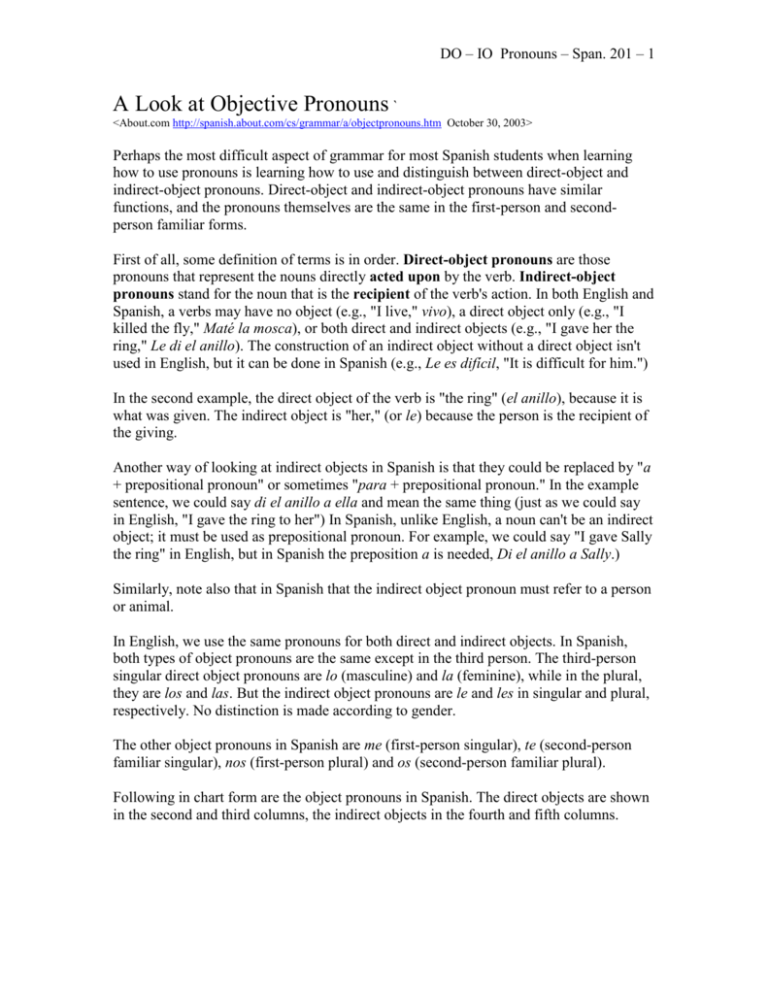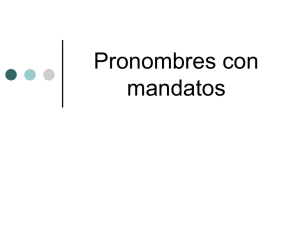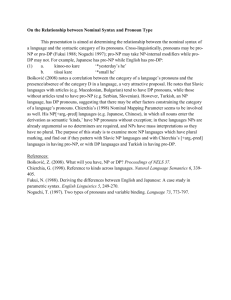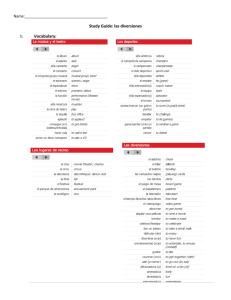A Look at Objective Pronouns `
advertisement

DO – IO Pronouns – Span. 201 – 1 A Look at Objective Pronouns ` <About.com http://spanish.about.com/cs/grammar/a/objectpronouns.htm October 30, 2003> Perhaps the most difficult aspect of grammar for most Spanish students when learning how to use pronouns is learning how to use and distinguish between direct-object and indirect-object pronouns. Direct-object and indirect-object pronouns have similar functions, and the pronouns themselves are the same in the first-person and secondperson familiar forms. First of all, some definition of terms is in order. Direct-object pronouns are those pronouns that represent the nouns directly acted upon by the verb. Indirect-object pronouns stand for the noun that is the recipient of the verb's action. In both English and Spanish, a verbs may have no object (e.g., "I live," vivo), a direct object only (e.g., "I killed the fly," Maté la mosca), or both direct and indirect objects (e.g., "I gave her the ring," Le di el anillo). The construction of an indirect object without a direct object isn't used in English, but it can be done in Spanish (e.g., Le es difícil, "It is difficult for him.") In the second example, the direct object of the verb is "the ring" (el anillo), because it is what was given. The indirect object is "her," (or le) because the person is the recipient of the giving. Another way of looking at indirect objects in Spanish is that they could be replaced by "a + prepositional pronoun" or sometimes "para + prepositional pronoun." In the example sentence, we could say di el anillo a ella and mean the same thing (just as we could say in English, "I gave the ring to her") In Spanish, unlike English, a noun can't be an indirect object; it must be used as prepositional pronoun. For example, we could say "I gave Sally the ring" in English, but in Spanish the preposition a is needed, Di el anillo a Sally.) Similarly, note also that in Spanish that the indirect object pronoun must refer to a person or animal. In English, we use the same pronouns for both direct and indirect objects. In Spanish, both types of object pronouns are the same except in the third person. The third-person singular direct object pronouns are lo (masculine) and la (feminine), while in the plural, they are los and las. But the indirect object pronouns are le and les in singular and plural, respectively. No distinction is made according to gender. The other object pronouns in Spanish are me (first-person singular), te (second-person familiar singular), nos (first-person plural) and os (second-person familiar plural). Following in chart form are the object pronouns in Spanish. The direct objects are shown in the second and third columns, the indirect objects in the fourth and fifth columns. DO – IO Pronouns – Span. 201 – 2 Direct Object Direct Object IO Indirect Object Me me Ella me ve (she sees me). me Ella me dio el dinero (she gave me the money). you (familiar) te Ella te ve. te Ella te dio el dinero. him, her, it, you (formal) lo (masculine) la (feminine) Ella lo/la ve. le Ella le dio el dinero. Us nos Ella nos ve. nos Ella nos dio el dinero. you (familiar plural) os Ella os ve. os Ella los/las ve. les Ella les dio el dinero. them, you (plural los (masculine) formal) las (feminine) Ella os dio el dinero. More about Objective Pronouns Here are some other details of using these pronouns you should know: El leísmo: In some parts of Spain, le and les are used as direct-object pronouns to refer to masculine human beings instead of lo and los, respectively. You're not likely to run into this usage, known as el leísmo, in Latin America. El laísmo: In some parts of Spain, la and las is used as an indirect-object pronouns to refer to femenine human beings instead of le and les, respectively. You're not likely to run into this usage, known as el laísmo, in Latin America. Se: To avoid alliteration, when le or les as an indirect-object pronoun precedes the directobject pronoun lo, los, la or las, se is used instead of le or les. Quiero dárselo, I want to give it to him (or her or you). Se lo daré, I will give it to him (or her or you). Placement of object pronouns after verbs: Object pronouns are placed after infinitives (the unconjugated form of the verb that ends in -ar, -er or -ir), gerunds (the form of the verb that ends in -ando or -endo, generally equivalent to the "-ing" ending in English), and the affirmative imperative. Quiero abrirla, I want to open it. No estoy abriéndola, I am not opening it. Ábrela, open it. Note that where the pronunciation requires it, an orthographic accent needs to be added to the verb. Placement of object pronouns before verbs: Object pronouns are placed before verb forms except those listed above, in other words, after nearly all the conjugated forms. DO – IO Pronouns – Span. 201 – 3 Quiero que la abras, I want you to open is. No la abro, I am not opening it. No la abras, don't open it. Order of object pronouns: When both direct-object and indirect-object pronouns are objects of the same verb, the indirect object comes before the direct object. Me lo dará, he will give it to me. Quiero dártelo, I want to give it to you. Obviously, there are quite a few rules to learn! But you'll find that as you read and listen to Spanish that the rules will become a natural part of your understanding of the language. Some exercises: Pronombres de complemento directo e indirecto: Instrucciones: Sustituya los sustantivos que sirven como complemento directo e indirecto con sus respectivos pronombres. A menos que usted desee lo contrario, es preferible que construya sus oraciones utilizando el presente de indicativo. http://www.indiana.edu/~call/ejercicios/imp_pron_dirind01.html DIRECT OBJECT PRONOUNS DO pronouns #1 Replace the DO noun with a pronoun. Scored. DO pronouns #2 Short translations in the present tense with DO pronouns. Good review of verbs that tend to take direct objects. DO pronouns #3 Practice DO pronouns in sentences with two verbs. INDIRECT OBJECT PRONOUNS IO pronouns #1 Provide IO pronouns and verbs in the present tense. DIRECT OR INDIRECT OBJECT PRONOUNS? DO or IO pronouns Select 3rd person DO or IO pronouns. Lots of feedback! DIRECT AND INDIRECT OBJECT PRONOUNS DO & IO pronouns #1 Replace both DO and IO nouns with pronouns. DO & IO pronouns #2 Give a logical response using DO and IO pronouns. DO & IO pronouns #3 Answer questions using both DO and IO object pronouns. http://www.colby.edu/~bknelson/exercises/DO_IO.html








